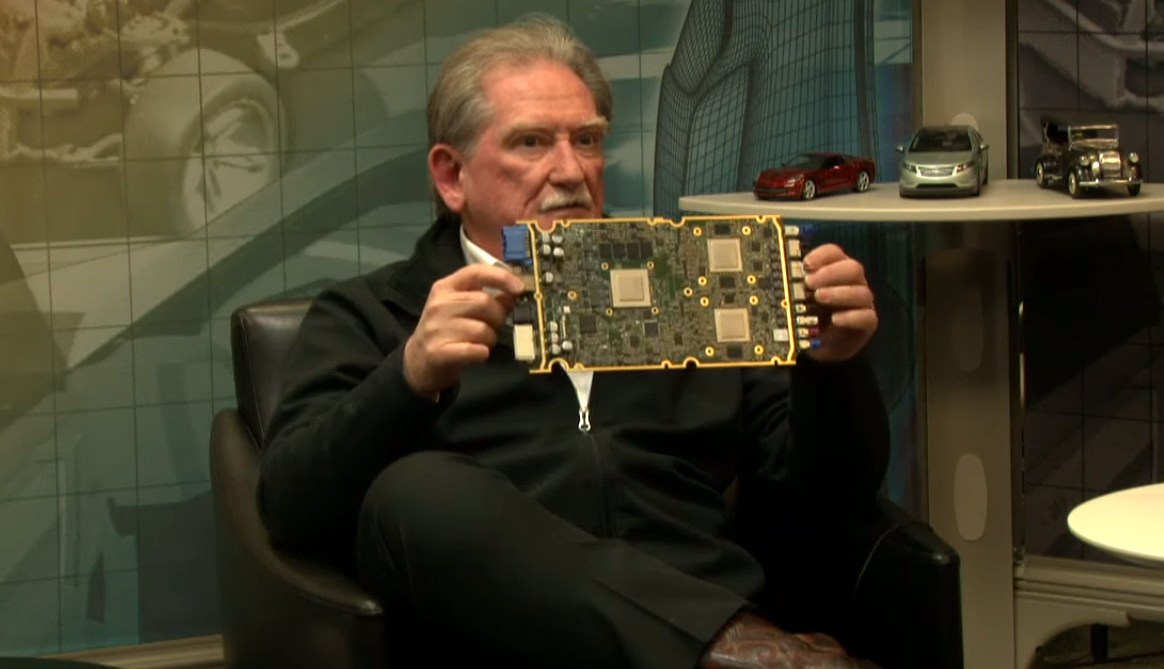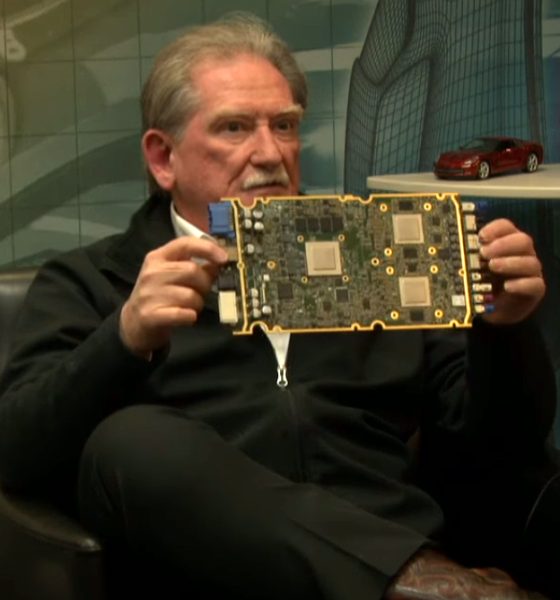

News
Tesla Model 3 modules are comparable to F-35 flight controller, says expert
Tesla Model 3 critic and Detroit veteran Sandy Munro discussed much of the results of his company’s teardown of the electric car in a recent episode of Autoline After Hours. In a lengthy discussion with the network’s panel, Munro explained what he liked about electric car, even gushing at one point and saying that the Model 3 electronics are comparable to a flight controller found on the Lockheed Martin F-35 Lightning II stealth multirole fighter.
In his most recent Autoline interview, Munro noted that his team is almost finished with its analysis and teardown of the electric car. While the Detroit veteran still maintained that he doesn’t have much good to say about the vehicle’s mechanical components, the Model 3’s electronics, battery, and suspension are a completely different matter.
According to Munro, the Model 3’s Automatic Drive Modules are a class above the industry, featuring a design architecture that is usually found on high-end electronics and government-grade machines. Munro even compared the Model 3’s drive module to the flight controller of the F-35, which he is familiar with due to his company’s work for the US military.
“If you look at this thing, this is cellphone technology. This is the technology we would see in really high-end computers, normally for the government. When you look at this, you’re looking at the same kind of technology you’d see on a flight controller for an F-35, and we kind of know a little bit about that too. We do work for the military. Everything here smacks of cellphone technology and defense technology,” Munro said.
The Detroit veteran further stated that Tesla could very well be the leader in battery tech today. According to Munro, prior to tearing down the Model 3, he believed that LG’s battery modules used in the Chevy Bolt EV are the best in the industry. Tesla’s batteries, however, are on a completely new level. Munro was particularly impressed with the differential between each one of the Model 3’s battery blocks.
“We went through there, and the difference was .2 milliamps. Holy, nobody can balance batteries that close. Nobody. Nobody’s ever done that,” Munro said.
Apart from the Model 3’s battery and its electronics, Munro also noted that the suspension for the Model 3 was excellent. The teardown specialist went so far as to state that the person who designed the car’s suspension could easily be an “F1 prince.”

A close-up of the Automatic Drive Module of the Tesla Model 3. [Credit: Autoline Network/YouTube]
“Dr. Jekyll and Mr. Hyde, that’s where they are. And that’s the good thing for the auto industry because if it would have just been a normal car from the mechanical side, from, like I say, the dinosaur technologies; if it came out decent with all the other stuff, they’d mop the floor with everybody,” he said.
Overall, Munro ultimately concluded that the Model 3 is a car that the industry should not dismiss, and that anyone in the automotive business who chooses to ignore Tesla’s progress is doing so at their own peril.
“Anybody that doesn’t look at the electronics on the Tesla (Model) 3 is out of his mind. They’re in peril. This is not some Mickey Mouse outfit that you can just dismiss. Anybody that’s in the car industry that ignores this car is doing it at their own peril,” Munro said.
“This is big stuff. This is not inching up. This is revolutionary, and everybody else is sitting there twiddling their thumbs.”
Sandy Munro is the CEO of Munro & Associates, a company specializing in vehicle teardowns and analysis. Previously featured in two of Autoline’s YouTube segments about the Model 3, Munro took a very critical stance on the electric car’s build quality, calling the Model 3 a “miserable job” and admitting that he “hated” some of the vehicle’s design elements. In a later video about the Model 3’s ride and drive, however, Munro admitted that while the vehicle’s fit and finish were horrible, its handling and performance were great.
Watch Autoline After Hours’ episode featuring Sandy Munro and the general results of his company’s Model 3 teardown in the video below.

Elon Musk
Elon Musk’s X will start using a Tesla-like software update strategy
The initiative seems designed to accelerate updates to the social media platform, while maintaining maximum transparency.

Elon Musk’s social media platform X will adopt a Tesla-esque approach to software updates for its algorithm.
The initiative seems designed to accelerate updates to the social media platform, while maintaining maximum transparency.
X’s updates to its updates
As per Musk in a post on X, the social media company will be making a new algorithm to determine what organic and advertising posts are recommended to users. These updates would then be repeated every four weeks.
“We will make the new 𝕏 algorithm, including all code used to determine what organic and advertising posts are recommended to users, open source in 7 days. This will be repeated every 4 weeks, with comprehensive developer notes, to help you understand what changed,” Musk wrote in his post.
The initiative somewhat mirrors Tesla’s over-the-air update model, where vehicle software is regularly refined and pushed to users with detailed release notes. This should allow users to better understand the details of X’s every update and foster a healthy feedback loop for the social media platform.
xAI and X
X, formerly Twitter, has been acquired by Elon Musk’s artificial intelligence startup, xAI last year. Since then, xAI has seen a rapid rise in valuation. Following the company’s the company’s upsized $20 billion Series E funding round, estimates now suggest that xAI is worth tens about $230 to $235 billion. That’s several times larger than Tesla when Elon Musk received his controversial 2018 CEO Performance Award.
As per xAI, the Series E funding round attracted a diverse group of investors, including Valor Equity Partners, Stepstone Group, Fidelity Management & Research Company, Qatar Investment Authority, MGX, and Baron Capital Group, among others. Strategic partners NVIDIA and Cisco Investments also continued support for building the world’s largest GPU clusters.
News
Tesla FSD Supervised wins MotorTrend’s Best Driver Assistance Award
The decision marks a notable reversal for the publication from prior years, with judges citing major real-world improvements that pushed Tesla’s latest FSD software ahead of every competing ADAS system.

Tesla’s Full Self-Driving (Supervised) system has been named the best driver-assistance technology on the market, earning top honors at the 2026 MotorTrend Best Tech Awards.
The decision marks a notable reversal for the publication from prior years, with judges citing major real-world improvements that pushed Tesla’s latest FSD software ahead of every competing ADAS system. And it wasn’t even close.
MotorTrend reverses course
MotorTrend awarded Tesla FSD (Supervised) its 2026 Best Tech Driver Assistance title after extensive testing of the latest v14 software. The publication acknowledged that it had previously criticized earlier versions of FSD for erratic behavior and near-miss incidents, ultimately favoring rivals such as GM’s Super Cruise in earlier evaluations.
According to MotorTrend, the newest iteration of FSD resolved many of those shortcomings. Testers said v14 showed far smoother behavior in complex urban scenarios, including unprotected left turns, traffic circles, emergency vehicles, and dense city streets. While the system still requires constant driver supervision, judges concluded that no other advanced driver-assistance system currently matches its breadth of capability.
Unlike rival systems that rely on combinations of cameras, radar, lidar, and mapped highways, Tesla’s FSD operates using a camera-only approach and is capable of driving on city streets, rural roads, and freeways. MotorTrend stated that pure utility, the ability to handle nearly all road types, ultimately separated FSD from competitors like Ford BlueCruise, GM Super Cruise, and BMW’s Highway Assistant.
High cost and high capability
MotorTrend also addressed FSD’s pricing, which remains significantly higher than rival systems. Tesla currently charges $8,000 for a one-time purchase or $99 per month for a subscription, compared with far lower upfront and subscription costs from other automakers. The publication noted that the premium is justified given FSD’s unmatched scope and continuous software evolution.
Safety remained a central focus of the evaluation. While testers reported collision-free operation over thousands of miles, they noted ongoing concerns around FSD’s configurable driving modes, including options that allow aggressive driving and speeds beyond posted limits. MotorTrend emphasized that, like all Level 2 systems, FSD still depends on a fully attentive human driver at all times.
Despite those caveats, the publication concluded that Tesla’s rapid software progress fundamentally reshaped the competitive landscape. For drivers seeking the most capable hands-on driver-assistance system available today, MotorTrend concluded Tesla FSD (Supervised) now stands alone at the top.
News
Elon Musk’s Grokipedia surges to 5.6M articles, almost 79% of English Wikipedia
The explosive growth marks a major milestone for the AI-powered online encyclopedia, which was launched by Elon Musk’s xAI just months ago.

Elon Musk’s Grokipedia has grown to an impressive 5,615,201 articles as of today, closing in on 79% of the English Wikipedia’s current total of 7,119,376 articles.
The explosive growth marks a major milestone for the AI-powered online encyclopedia, which was launched by Elon Musk’s xAI just months ago. Needless to say, it would only be a matter of time before Grokipedia exceeds English Wikipedia in sheer volume.
Grokipedia’s rapid growth
xAI’s vision for Grokipedia emphasizes neutrality, while Grok’s reasoning capabilities allow for fast drafting and fact-checking. When Elon Musk announced the initiative in late September 2025, he noted that Grokipedia would be an improvement to Wikipedia because it would be designed to avoid bias.
At the time, Musk noted that Grokipedia “is a necessary step towards the xAI goal of understanding the Universe.”
Grokipedia was launched in late October, and while xAI was careful to list it only as Version 0.1 at the time, the online encyclopedia immediately earned praise. Wikipedia co-founder Larry Sanger highlighted the project’s innovative approach, noting how it leverages AI to fill knowledge gaps and enable rapid updates. Netizens also observed how Grokipedia tends to present articles in a more objective manner compared to Wikipedia, which is edited by humans.
Elon Musk’s ambitious plans
With 5,615,201 total articles, Grokipedia has now grown to almost 79% of English Wikipedia’s article base. This is incredibly quick, though Grokipedia remains text-only for now. xAI, for its part, has now updated the online encyclopedia’s iteration to v0.2.
Elon Musk has shared bold ideas for Grokipedia, including sending a record of the entire knowledge base to space as part of xAI’s mission to preserve and expand human understanding. At some point, Musk stated that Grokipedia will be renamed to Encyclopedia Galactica, and it will be sent to the cosmos.
“When Grokipedia is good enough (long way to go), we will change the name to Encyclopedia Galactica. It will be an open source distillation of all knowledge, including audio, images and video. Join xAI to help build the sci-fi version of the Library of Alexandria!” Musk wrote, adding in a later post that “Copies will be etched in stone and sent to the Moon, Mars and beyond. This time, it will not be lost.”








